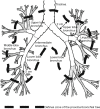Medically inoperable stage I non-small cell lung cancer: best practices and long-term outcomes
- PMID: 30788233
- PMCID: PMC6351401
- DOI: 10.21037/tlcr.2018.06.11
Medically inoperable stage I non-small cell lung cancer: best practices and long-term outcomes
Abstract
Early-stage non-small cell lung cancer (ES-NSCLC) currently represents a minority of all NSCLC diagnoses but, with ongoing refinement and improvement of treatment approaches, is a group with increasing likelihood of long-term disease control and survival. A significant proportion of this population will not be optimal candidates for definitive surgical resection due to tumor characteristics, patient frailty, or comorbid status. The clinical evidence to support the use of stereotactic body radiation therapy (SBRT) in patients with medically inoperable stage I NSCLC is growing as long-term data are obtained. In this review, initial workup, SBRT delivery considerations, recent trial data, and post-treatment surveillance of this population are discussed.
Keywords: Stereotactic body radiation therapy (SBRT); early stage; inoperable; lung cancer; stereotactic ablative radiotherapy.
Conflict of interest statement
Conflicts of Interest: The author has no conflicts of interest to declare.
Figures


References
-
- American Cancer Society. Global Cancer Facts & Figures 3rd Edition. Atlanta: American Cancer Society, 2015.
-
- Ferlay J, Soerjomataram I, Ervik M, et al. GLOBOCAN 2012 v1.0, Cancer Incidence and Mortality Worldwide: IARC CancerBase No. 11. Lyon, France: International Agency for Research on Cancer, 2013.
-
- Cancer of the Lung and Bronchus (Invasive). In: Howlader N, Noone AM, Krapcho M, et al. editors. SEER Cancer Statistics Review, 1975-2014. Bethesda, MD: National Cancer Institute, 2017.
-
- Amin MB, Edge S, Greene F, et al. AJCC Staging Manual. 8th Ed. New York, NY: Springer International Publishing, 2017.
Publication types
LinkOut - more resources
Full Text Sources
